The Mets, however, will got to Milwaukee this season, for a 3-game series, starting next Friday.
Before You Go. Milwaukee is on Lake Michigan, which makes it chilly in the winter. But this is early May, so the weather shouldn't be much of an issue.
The Milwaukee Journal Sentinel website is predicting high 50s for the afternoons and high 40s for the evenings. They are predicting a 20 to 40 percent chance of rain for the entire weekend, so bring an umbrella. However, Miller Park has a retractable roof, so it won't rain on you during the games.
Milwaukee is in the Central Time Zone, an hour behind New York. Adjust your various timepieces accordingly.
Tickets. In spite of 2 Playoff berths in a recent 4-season stretch (2008 & '11), the Brewers only drew an average of 28,575 fans last season, due to their tailoff. Still, that was better than they usually do, and, while it's nowhere near the rival Cubs, it's a lot better than the also-nearby White Sox. Nevertheless, as the Mets and Brewers have never had a rivalry, you should be able to buy any ticket you can afford.
On the Field Level (lower), Infield Boxes are $58 and Outfield Boxes are $42. On the Loge (middle), Infield Boxes are $42 and Outfield Boxes are $34. On the Terrace (upper), Boxes are $25 and Reserved are $18. Bleachers are $24.
Getting There. Downtown Milwaukee is 879 land miles from Times Square. And Miller Park is 893 miles from Citi Field, 887 miles from Yankee Stadium II. Knowing this, your first reaction is going to be to fly out there.
At first, unlike some other Midwestern cities, this seems like a good idea if you can afford it. If you order today, American Airlines can fly you there for under $600 round-trip. However, there is a catch: There are no non-stops between any of the New York area airports and General Mitchell International Airport in Milwaukee: You will change planes, most likely in Chicago, and you'll spend nearly as much time on the ground at O'Hare as you do in the air. The GRE bus will get you downtown in a little over half an hour.
(Billy Mitchell was a Milwaukee-area native, a General in the U.S. Army Air Service, and an early advocate for air power. Although he didn't live to see its establishment, he is called the Father of the U.S. Air Force.)
The Milwaukee Intermodal Station, which serves both Greyhound and Amtrak, is at 433 W. St. Paul Avenue, at 5th Street. There are 4 daily Greyhound runs that will get you from New York to Milwaukee. Only 1 requires as few as 1 changeover.
That bus leaves Port Authority at 10:15 PM, and includes rest stops at Milesburg, Pennsylvania; Cleveland and Toledo, before arriving in Chicago at 3:10 the next afternoon (Central Time). There's a half-hour's wait before leaving Chicago at 3:40 and arriving in Milwaukee at 6:20. That's a little under 21 hours, counting the time change. So if you leave Port Authority at 10:15 on Thursday night, you'll might not arrive in Milwaukee with enough time to check into a downtown hotel and get out to the ballpark in time for the Friday night game. Better to take the Thursday 5:15 PM bus out of New York, changing at Cleveland at 2:35 AM and Chicago at 10:30 AM, and arriving in Milwaukee at 1:55 PM.
You can return home at 8:50 Sunday night, although you'll have to make transfers at Chicago (10:35 PM), Detroit (6:05 AM), and Pittsburgh (2:40 PM) to get back to Port Authority by 11:55 PM. Round-trip fare is $295.
Milwaukee Intermodal Station
Amtrak's Lake Shore Limited (formerly known as the Twentieth Century Limited when the old New York Central Railroad ran it from Grand Central Terminal to Chicago's LaSalle Street Station) leaves New York's Penn Station at 3:40 every afternoon, and arrives at Union Station at 225 South Canal Street in Chicago at 9:45 (Central Time) every morning. From there, you have to wait until 1:05 PM to get on Hiawatha Service, which will bring you to Milwaukee at 2:34. That's 23 hours, 49 minutes.
If you start this trip on Thursday afternoon in order to see the entire 3-game series, you can leave Milwaukee by Amtrak on 5:45 on Sunday afternoon, be in Chicago at 7:14, and leave Chicago on the Lake Shore Limited at 9:30 and arrive back at Penn Station at 6:23 PM on Monday. Round-trip fare is $266.
If you decide to drive, it's far enough that it will help to get someone to go with you and split the duties, and to trade off driving and sleeping. You'll need to get into New Jersey, and take Interstate 80 West. You'll be on I-80 for the vast majority of the trip, through New Jersey, Pennsylvania and Ohio. In Ohio, in the western suburbs of Cleveland, I-80 will merge with Interstate 90. From this point onward, you won't need to think about I-80 until you head home; I-90 is the key, until it merges with Interstate 94, which will merge with Interstate 43, but you have to worry only about I-94.
I-94 will split off from I-43 at downtown Milwaukee, and then "turn left," becoming the East-West Freeway. Take Exit 308A for Mitchell Blvd., then turn right on Frederick Miller Way (named for the founder of Miller Beer; a left turn will get you onto Selig Drive, named for the Commissioner and former Brewer owner). The ballpark will be on your left.
If you do it right, you should spend about an hour and a half in New Jersey, 5 hours and 15 minutes in Pennsylvania, 4 hours in Ohio, 2 hours and 30 minutes in Indiana, an hour and a half in Illinois, and just under an hour in Wisconsin. That's about 15 hours and 45 minutes. Counting rest stops, and accounting for traffic in both New York and Chicago, it should be no more than 20 hours, which would save you time on both Greyhound and Amtrak, if not on flying.
Once In the City. As Alice Cooper taught us in the film version of Wayne's World, Milwaukee gets its name from a Native American word meaning "the good land." But this may not be correct: Another version says the name comes a word meaning "Gathering place by the water." Either way, it's true: The land of Wisconsin is good for farming, and Milwaukee is based on a confluence of 3 rivers that flow into Lake Michigan: The Milwaukee, the Menomonee, and the Kinnickinnic; so there's plenty of water. The Milwaukee River separates the city's streets into North and South, and the other 2 rivers separate them into East and West.
Founded in 1846, the city has about 600,000 people, making the 3rd-largest in the Great Lakes region behind Chicago and Detroit. But the metropolitan area has only about 2 million, making it dead last among the 30 MLB teams, about 400,000 less than Number 29, Kansas City. But the construction of modern Miller Park means that the Brewers, unlike the Braves to Atlanta in 1965, won't be moving out of Milwaukee in the foreseeable future.
Wisconsin's sales tax is 5 percent, but inside Milwaukee County, it's 5.6 percent. Which is still lower than those of the States of New York, New Jersey and Connecticut even before local taxes are added on. The Milwaukee County Transit System has buses only, no subway or light rail, and has a fare of $2.25.
ZIP Codes in Wisconsin start with the digits 53 and 54, and for the Milwaukee area, 530, 531 and 532. The Area Code is 414 for the city and 262 for the suburbs. Milwaukee does not have a "beltway."
Going In. Getting from downtown to Miller Park by public transportation is a little tricky. The Number 10 bus goes down Wisconsin Avenue, but its closest point is a little over a mile from the stadium. You'd need to get off at the intersection of Wisconsin Avenue and 45th Street, make a left on Story Parkway and a left at the fork onto Yount Drive.
Helfaer Field, with Miller Park beyond right field
You'll walk under I-94, and on your right will be Helfaer Field, a baseball field on the site of Milwaukee County Stadium. Miller Park, named for the city's brewing giant, will be straight ahead.
Milwaukee has its bad neighborhoods, but like County Stadium, Miller Park is an island in a sea of parking, so regardless of whether you took a bus or drove, you should be safe. The stadium points southeast, as did County Stadium before it, but that doesn't matter a whole lot, since you're 4 miles west of downtown and Milwaukee doesn't exactly provide a great view of skyscrapers. The official address for "The Keg" is 1 Brewers Way. Parking at Miller Park is $25.
Outside the ballpark, there is a sculpture titled "Teamwork," in memory of the 3 construction workers killed in the collapse of a crane in 1999: William DeGrave, Jerome Starr and Jeffrey Wischer. The collapse not only killed those men, but damaged the unfinished stadium so badly that its opening date had to be pushed back from April 2000 to April 2001.
As I said, Miller Park has a retractable roof. At this time of year, the roof is likely to be open, unless it gets hot -- and, as I said when citing the forecast, it probably won't get hot (but rain may be a factor). The park is not symmetrical: Left field is 344 feet from home plate, left-center is 371, center is 400, right-center is 374, and right is 345. It's better for hitters with the roof closed, better for pitchers with the roof open. The field is natural grass, and points southeast.
Russell Branyan hit the longest home run at Miller Park so far, a 480-foot shot in 2004. I can't find a definitive answer as to who hit the longest homer at County Stadium, although the only player who appears to have hit one all the way out of it was Cecil Fielder, with a 1991 drive that went 502 feet. Oddly, his son Prince Fielder would later play for the Brewers, but he didn't hit the longest at Miller Park before going to the American League and playing for his father's team, the Detroit Tigers.
For all the home runs hit by sluggers such as Hank Aaron, Eddie Mathews, Joe Adcock, Gorman Thomas and Rob Deer while County Stadium was their home park, I can find no record of any of them hitting one there that was longer than Cecil's 502-footer.
Miller Park hasn't yet hosted pro football, but it's hosted "futbol." During the 2014 All-Star Break, Swansea City of Wales and Chivas of Guadalajara, Mexico played to a 1-1 draw. During the 2015 All-Star Break, it was Britain vs. Mexico again: Atlas defeated Newcastle United 2-1. The ballpark has also hosted concerts, including Bruce Springsteen in 2003, Paul McCartney in 2013 and One Direction in 2015.
Food. In Big Ten Country, where tailgate parties are practically a sacrament, you would expect the Milwaukee ballpark to have lots of good options. With Wisconsin's German heritage in mind, there are Beer Carts and Brat Boys stands all over the place, and a Friday's Beer Garden at the Left Field Gate. A "bratwurst with red sauce" has been one of Major League Baseball's most-honored culinary delights since the Braves were in town. The Brewers also serve various other sausages, many of them of ethnic varieties, as reflected in the Sausage Race.
Like Greg Luzinski in Philadelphia, Boog Powell in Baltimore, and a few others, Milwaukee has a barbecue stand operated by a club legend, in this case "Stormin' Gorman" Thomas. Gorman's Corner is behind Section 103 in right field. There's a Fry Bar at Section 106, baked potato stands at 125 and 214, and "Hot Cheese" at 208. (Hot cheese? Yes, they serve grilled cheese sandwiches and cheese fries.) Big B's Diner has locations at 110 and 126, and Bernie's Clubhouse, named for Bernie Brewer, at 422. Friday's Front Row Sports Grille -- named after a line from a Miller Lite commercial that Bob Uecker did back in the day -- is in left field.
According to a recent Thrillist article on the best food at each big-league ballpark, the best thing to eat at Miller Park is "Bratchos on a stick." What-chos on a stick? It's a fried wad of cheese, seasoned ground beef (that would be the "brat" part), crushed Doritos (that would be the "chos" part) and sour cream on a 6-inch toothpick. I think if you can eat three without having a heart attack, you should get the next one free. It's available all over the stadium.
Fortunately, the ballpark has several ice cream stands. Unfortunately, the ice cream is Blue Bunny, which I suggest staying away from. Blue Bunny is so bad (How bad is it?), it makes Turkey Hill taste like Breyer's. But there are also Dippin' Dots stands.
Team History Displays. In addition to "Teamwork," Miller Park has statue honors for 4 significant figures from Milwaukee's baseball history: Hank Aaron of the Braves (who also played his last 2 years with the Brewers), Brewers founding owner Allan H. "Bud" Selig (now the Commissioner), shortstop Robin Yount, and Bob Uecker, who was the 1st Milwaukee (or even Wisconsin) native to play for the Braves, and now longtime broadcaster for the Brewers.
Aaron, Selig and Yount at the dedication for Selig's statue
It was because Major League was filmed in Milwaukee, rather than Cleveland, that Ueck was hired to play the Indians' acerbic, hard-drinking broadcaster Harry Doyle -- a man much closer in personality to Harry Caray than to the real Ueck.
I don't think Ueck's statue looks much like him.
The Brewers' retired numbers are high above center field: 1, Bud Selig, owner 1970-98 (never worn by him, obviously); 4, Paul Molitor, 3rd baseman and designated hitter 1978-92; 19, Robin Yount, shortstop-center field 1973-93; 34, Rollie Fingers, pitcher 1981-85; 44, Hank Aaron, designated hitter 1975-76; and the universally-retired 42 of Jackie Robinson.
The Brewers have also not reissued, though not also retired, the Number 17 of Wisconsin native Jim Gantner, 2nd baseman 1976-92. They have also honored Uecker with a not-retired, still-in-circulation Number 50, which hangs with the retired numbers in honor of Uecker's first 50 years in pro baseball. If you saw Mr. 3000, sorry, but Stan Ross (1st base, 1978-95 & 2004 -- taking the place of Cecil Cooper for a few years) is fictional, and his Number 21 has not been retired: It is currently worn by 3rd baseman Travis Shaw.
The Brewers have a team Wall of Honor, with a whopping 59 members:
* Straddling the eras: Selig and Uecker.
* From the 1970s, but not making it into the team's 1st era of contention: Aaron; pitchers Ken Sanders and Jim Colborn; outfielders Dave May and Johnny Briggs; catcher Darrell Porter; and 1st baseman George Scott.
* From the 1978 team that was the 1st Brewer squad to make it into a Pennant race, but not making it to the 1982 Pennant: Pitchers Bill Castro and Bill Travers, outfielder Sixto Lezcano and 3rd baseman Sal Bando.
* From the 1982 Pennant winners: Yount, Molitor, Fingers, Gantner, Sutton, Thomas; manager Harvey Kuenn (a Milwaukee native who had once played for the Braves); pitchers Jim Slaton, Jerry Augustine, Moose Haas, Mike Caldwell, Bob McClure and Pete Vukovich; catcher Ted Simmons, 1st baseman Cecil Cooper, 3rd baseman Don Money, left fielder Ben Oglivie and right fielder Charlie Moore.
* From the close calls of 1987 and 1988, but joining after the 1982 Pennant: Pitchers Teddy Higuera, Bill Wegman, Chris Bosio, Dan Plesac and Chuck Crim; catcher Bill Schroeder (now a Brewers broadcaster), and outfielders Rob Deer, B.J. Surhoff and Darryl Hamilton.
* From the 1990s: Pitchers Jaime Navarro, Cal Eldred, Mike Fetters and Bob Wickman; catcher Dave Nilsson, 1st baseman John Jaha, 2nd basemen Fernando Viña and Mark Loretta, shortstops Pat Listach and José Valentín, 3rd basemen Kevin Seitzer and Jeff Cirillo; and outfielders Greg Vaughn and Jeromy Burnitz.
* From the 2000s, but not making it to 2008: 1st baseman Richie Sexson and outfielder Geoff Jenkins.
* From the 2008 Wild Card team: Pitcher Ben Sheets, and infielders Bill Hall and Craig Counsell. Counsell is the only player thus far honored from the Brewers' 2011 NL Central Division Champions.
The Brewers also have a Milwaukee Baseball Walk of Fame, honoring greats from both teams. In addition to Selig, Kuenn, Uecker, Aaron, Yount, Molitor, Fingers, Money, Thomas, Gantner, and Higuera, it honors former general manager Harry Dalton. From the Braves, it honors Aaron, Kuenn, pitchers Warren Spahn and Lew Burdette, 3rd baseman Eddie Mathews, 1st baseman Joe Adcock, shortstop Johnny Logan and general manager John Quinn.
In addition to Aaron, Spahn, Mathews, Yount, Molitor, Thomas, Gantner, Kuenn, Cooper, Selig and Uecker, the Wisconsin Athletic Hall of Fame has honored Braves broadcaster Earl Gillespie; minor-league Brewers stars Charlie Grimm and Joe Hauser, and Wisconsin-born baseball stars Kid Nichols, Ginger Beaumont, Davy Jones, Addie Joss, Billy Sullivan, George McBride, Fred Luderus, Pants Rowland, Ed Konetchy, Burleigh Grimes, Al Simmons, Ray Berres and Ken Keltner. Nichols, Joss, Grimes and Simmons are in the Baseball Hall of Fame.
Aaron and his fellow Milwaukee Brave Warren Spahn were named to the Major League Baseball All-Century Team in 1999. That same year, The Sporting News named Aaron, Spahn, Braves star Eddie Mathews, Fingers and Molitor to their 100 Greatest Baseball Players.
In the TV special that NBC did for the 100 Greatest Baseball Players, John Rawlings, then TSN's editor, admitted that, despite being a Hall-of-Famer, a member of the 3,000 Hit Club and an MVP at 2 different positions, Yount was one of the last players cut. Yount was, however, honored by Brewer fans as their team's entry in the 2006 DHL Hometown Heroes poll.
The Brewers hang their notations for their 1981 American League Division Series appearance, their 1982 AL Pennant, their 2008 National League Wild Card berth, and their 2011 NL Central Division title over the left-field fence, over the Front Row Sports Grille. There is also a Braves Monument at Miller Park. But there is no mention of the Braves' 1957 World Championship or 1958 NL Pennant, or the 8 American Association Pennants won by the Triple-A version of the Milwaukee Brewers in 1913, 1914, 1936, 1943, 1944, 1945, 1951 and 1952.
Stuff. The Brewers Team Stores are located at the Home Plate and Left Field Gates. The usual items that can be found at a souvenir store can be found there.
The Brewers have been around for over 40 years now, but because Milwaukee, as a city, gets lost in the shadows not only of Chicago, 90 miles to the south, but the smaller yet higher-profile city of Green Bay, 115 miles to the north, the Brewers tend to get forgotten. They trail not only the Packers, but also the football team at the University of Wisconsin in popularity among Badger State teams. (They may even trail that school's very successful hockey program, even though Milwaukee doesn't have an NHL team.)
Their recent success has moved them ahead of the NBA's Bucks, though: While the Bucks are usually good, they haven't reached the NBA Finals in almost 40 years, and their 1971 title seems so far back that it might as well have been won by a team that moved away and has since been replaced, as with Minneapolis and the Lakers. Or with the Braves and Brewers, if you prefer.
As a result of this, there aren't many good books about the Brew Crew. Todd Mishler wrote Baseball in Brewtown: America's Pastime in Milwaukee. It covers not just the Brewers, but their preceding Triple-A namesake, and the Braves, and the teams that called the city home in the 19th Century. But it was published in 2005, and doesn't cover the recent renaissance that saw the Brewers win the NL's Wild Card in 2008 and the NL Central in 2011.
Milwaukee's greatest baseball moment -- their only World Championship in the sport to date -- came when the Yankees, finding the much smaller city's over-the-top reaction to the Brewers to be comical, called Milwaukee "Bushville" (as in "bush league"), and came to regret it. This story is told in John Klima's book Bushville Wins! The Wild Saga of the 1957 Milwaukee Braves and the Screwballs, Sluggers, and Beer Swiggers Who Canned the New York Yankees and Changed Baseball. The title is longer than the Series was -- and both the '57 and the '58 Series went the full 7.
The 1957 World Series' official highlight film seems not to be in an official package sold at either Brewers or Braves games. The Brewers do have a DVD honoring their lone Pennant: Harvey's Wallbangers: The 1982 Milwaukee Brewers. Uecker narrates this story about Kuenn and his leadership of a club that had been terrible until 1977, then became a "close but no cigar" team under George Bamberger, before Bambi was fired and Kuenn was brought in, turning "Bambi's Bombers" into "Harvey's Wallbangers."
There is also a DVD titled The Essential Games of the Milwaukee Brewers. While there are a few bonus features, there are only 4 games on it, as opposed to the standard 6: 1982 AL Championship Series Game 5, in which the Brew Crew won what is still their only Pennant; 1982 World Series Game 4, a come-from-behind victory in a Series they went on to lose in 7; September 28, 2008, a date which lives in Met infamy but in Brewer legend as they clinched the Wild Card berth by beating their arch-rivals, the Cubs; and 2011 NL Division Series Game 5, in which they beat the Arizona Diamondbacks to win a postseason series for the 1st time in 29 years (and only the 2nd time in their 1st 43 years of play).
During the Game. A recent Thrillist article on "Baseball's Most Intolerable Fans" ranked Brewer fans 30th. Dead last. In other words, the most tolerable: "You'd be hard-pressed to find a more affable fanbase than Brewers fans. They just kind of roll with things."
Brewer fans, as you might expect in America's foremost brewing city, like to drink. If this were a Packer game and you were wearing Chicago Bears or Minnesota Vikings gear, you might be in trouble. If this were a UW game and you were wearing University of Minnesota gear, you might be in trouble. If this were a Bucks game and you were wearing Chicago Bulls gear, you'd probably be safe. If this were a Brewers-Cubs game, and you were wearing Cubs gear, you might be in trouble. But it's a Brewers-Mets game, so if you don't start anything, they won't continue anything. Wisconsans are good people.
Apparently, the Wisconsin-Minnesota rivalry
doesn't extend to the mascots. Bernie Brewer poses
with the Twins' T.C. Bear at the Twins' Target Field.
All 3 games of these series feature promotions. Friday is Student Night. Saturday is Brewers Coupon Book Night: The 1st 25,000 fans age 18 and over receive a Brewers coupon book -- probably for places you may never get another chance to visit, since you don't live in Wisconsin. Sunday is Brewers Wristlet Day, with the 1st 20,000 fans getting a Brewers wristlet.
Since 1973, the Brewers have had a mascot, Bernie Brewer. At County Stadium, there was a giant keg and beer stein behind center field, with a chalet next to it. Upon each Brewer home run, Bernie, a man in a costume whose big foam head had a big blond mustache, would slide down a chute from the chalet into the mug, releasing balloons.
Bernie's Chalet at County Stadium
The setup was removed in 1984, but restored in 1993. A new version was installed in left field when Miller Park opened in 2001.
Bernie's slide at Miller Park
The Sausage Race began in in the 1980s, as a cartoon show on the scoreboard. Live races by men (sometimes women) in 7-foot-3 sausage suits began in 1994: They would come out of the left field gate and run toward home plate.
The original sausages are #1, Brett Wurst (a bratwurst in lederhosen, representing the city's German heritage); #2, Stosh (a guy in a rugby-style shirt, cap and sunglasses, representing a Polish sausage), and #3, Guido (wearing a chef's outfit and having a long, thin mustache, representing an Italian sausage). #4, Frankie Furter (a guy in a baseball uniform and wearing eye-black, representing standard hot dogs) was added in 1995; and #5, Cinco (a sombrero-wearing Chorizo, a nod to Latino fans) was added in 2006.
The original cartoon version was inspired by the "Dot Race" that used to appear on the scoreboard at Texas Rangers games, which also inspired the Airplane Race on the DiamondVision board at Mets games and The Great City Subway Race at Yankee games. Since then, the Rangers have returned the favor, having made the Dot Race live-action, but they are designed to resemble Texas pioneers Davy Crockett, Jim Bowie and Sam Houston.
In addition, the Pittsburgh Pirates have the Great Pierogi Race, the Washington Nationals have the Racing Presidents, and several other teams have mascot races involving their various sponsors.
The Brewers hold auditions for National Anthem singers, instead of having a regular. In the 7th inning stretch, after playing "Take Me Out to the Ballgame," the Brewers play "The Beer Barrel Polka": "Roll out the barrel, we'll have a barrel of fun... " Their postgame victory song is "Best Day of My Life" by the American Authors.
After the Game. As Miller Park is separated from the city by parking, safety should not be an issue. Although Milwaukeeans like to drink, this is not a Packers or Badgers game, so you should be fine. Unfortunately, this same distance from, well, anything means that there's no good places to get a postgame meal or drink within walking distance.
The difference between the Brewers' ballpark (past and present) and the Bucks' arena (past, present and future) could not be more stark. At 340 W. Kilbourn Avenue, across 4th Street from the MECCA and a block from the Bradley Center is "Milwaukee's Sports Headquarters," one of the most famous sports bars in the country, Major Goolsby. "The Major's" has been catering to Wisconsin sports fans since 1971. That was when the Bucks won the NBA title... and they haven't won it since. Hmmmm... Curse of Major Goolsby, anyone?
Unfortunately, I can find no reference to any Milwaukee bar or restaurant that caters to New York expatriates.
If you visit Milwaukee during the European soccer season (which is reaching its climax, and will start up again in mid-August), the best place to watch your favorite club is the Highbury Pub, at 2322 S. Kinnickinnic Avenue at Lincoln Avenue, about 3 miles south of downtown. Bus 15. Named for the former stadium of Arsenal Football Club, which was named for the North London neighborhood it was in, there is also a bar by that name in Brooklyn.
Sidelights. Milwaukee's sports history is long, but not especially successful, especially when you consider the 119-mile distance between the city and the State's most successful sports team, the Green Bay Packers. Milwaukee County Stadium was located behind the home plate entrance to Miller Park (which was built across center field from its predecessor).
County Stadium during the 1957 World Series
The Braves played there from 1953 to 1965, the Brewers from 1970 to 2000, and the Packers played several home games there from 1953 to 1994, first 2 out of their 6 (when the NFL had a 12-game schedule), then 2 of their 7 (14), and finally 3 of their 8 (16), plus a preseason game (an another preseason game at the University of Wisconsin's Camp Randall Stadium). The Packers played a Playoff game against the Los Angeles Rams at County Stadium in 1967, before winning the NFL Championship against the Dallas Cowboys at Lambeau Field on New Year's Eve, the famed Ice Bowl.
County Stadium in the Brewers' glory days of the 1980s
County Stadium hosted the only game, to date, played by the U.S. national soccer team in Wisconsin. It was on July 28, 1990, against East Germany, in one of that foul country's last games before being reunited with their Federal Republic (West German) brothers. We lost.
It was at "Borchert's Orchard" that he first tried his promotional stunts, and it made Milwaukee one of the most successful minor-league markets, not just on the field but at the box office.
The Brewers won 8 American Association Pennants there: 1913, 1914, 1936, 1943, 1944, 1945 (that's 3 straight under Veeck's ownership), 1951 and 1952 (in their last 2 seasons of existence before the Braves came in).
The best-known photo of Borchert Field, showing its
Polo Grounds-like dimensions. No, I don't know
why the area behind the foul lines looks dug-up.
The Milwaukee Bears of the Negro Leagues also played here, as did the Milwaukee Badgers of the NFL from 1922 to 1926, and the Packers played the occasional Milwaukee game here from 1933 to 1952.
Actually, the place was better for football than for baseball: Like the Polo Grounds, it had a distant center field but foul poles that were much too close, 267 feet. An overhanging roof that covered the infield stands didn't help matters. As Veeck himself put it, "Borchert Field, an architectural monstrosity, was so constructed that the fans on the first-base side of the grandstand couldn't see the right fielder, which seemed perfectly fair in that the fans on the third-base side couldn't see the left fielder. 'Listen,' I told them. 'This way you'll have to come back twice to see the whole team.'"
A rare color photo of Borchert Field.
I didn't even know that this photo existed until today.
Borchert stood between North 7th & 8th Streets, and Burleigh & Chambers Streets. The entire land area is now occupied by Interstate 43, the North-South Freeway, and entrance-and-exit ramps. It's in a bit of a rough neighborhood, so unless you're just that into baseball history, if you have to cross one item off your list, this is the one. Number 50 bus to Holton & Burleigh, then Number 60 bus, or walk 12 blocks west.
* Milwaukee Mile. This racetrack, on the grounds of the Wisconsin State Fair in suburban West Allis, is the oldest continuously-operating auto racetrack in the world. "But Mike," you say, "auto racing is not a sport. Why are you talking about it?" Because the track's infield was used as the Packers' main Milwaukee-area home from 1934 to 1951.
Seating 45,000, the stadium was nicknamed the Dairy Bowl for Packer games, including the 1939 NFL Championship Game, in which the Packers beat the Giants, 27-0. The Milwaukee Chiefs of the 1940-41 version of the American Football League also played here.
I don't know if this is the earliest remaining stadium to have hosted an NFL game (1933), but it's almost certainly the oldest site (racing began there in to 1903). 7722 W. Greenfield Avenue at 77th Street. Number 60 bus to 60th & Vliet Streets, then transfer to Number 76 bus.
* Bucks arenas. The old and current Milwaukee arenas, across State Street from each other at 4th Street, are loaded with history. The old one, built in 1951, now known as the U.S. Cellular Arena, was originally known as the Milwaukee Arena, then from 1974 to 1995 as the Milwaukee Exposition Convention Center and Arena (or MECCA). Two NBA teams called it home: The Milwaukee Hawks from 1951 to 1955, before moving to St. Louis (and later to Atlanta); and the Milwaukee Bucks from their debut in 1968 until 1988.
The Bucks played their 1971 NBA Championship season, their only title, there, although they clinched on the road in Baltimore. The Milwaukee Admirals, a minor-league hockey team, played here from 1973 to 1988, and won the 1976 United States Hockey League title.
Elvis Presley sang here on June 28, 1974 and April 27, 1977. The Beatles played here on September 4, 1964. The inductees to the previously mentioned Wisconsin Athletic Hall of Fame are honored here in a Wisconsin Athletic Walk of Fame, which also includes Green Bay Packers, Milwaukee Bucks, Wisconsin Badgers, and State natives who made it big elsewhere.
The MECCA, with the Bradley Center behind it
The current arena, now the BMO Harris Bradley Center, has been the Bucks' home since 1988. While they've usually been good, they haven't reached the NBA Finals since 1974 (at the MECCA) or even the Conference Finals since 2001 (at the Bradley Center). The Admirals also call the Bradley Center home, and won the 2004 Calder Cup here. Marquette University, which reach the 1974 NCAA National Championship and won it in 1977, also plays at the Bradley Center, after having played at the MECCA and before that at the site I'm about to mention.
The University of Wisconsin, in Madison, is the only other Wisconsin school to reach the Final Four, and that was all the way back in 1941, although they've reached hockey's version, the Frozen Four, many times.
The Bradley Center, like a lot of NBA and NHL arenas that have recently been replaced or are about to be, opened right before Baltimore's ballpark, Camden Yards, rewrote the rules for stadium and arena construction. As a result, while the Bradley Center is in good shape and has good sight lines, it does not have lots of revenue-generation luxury boxes. And, with Milwaukee being a small market (only the Packers' special status keeps Wisconsin capable of supporting an NFL team, and the Brewers were in serious trouble in the 1990s before Miller Park opened), the Bucks need those luxury boxes.
For that reason, ground will be broken this month on a new arena, just to the northwest of the Bradley Center, at 5th Street & Highland Avenue. The Bucks and Marquette basketball are expected to move in for the 2018-19 season. Presumably, the Bradley Center will be demolished, while the MECCA will remain standing due to its historical significance.
Artist's rendering of the new arena.
It kind of looks like a beer keg lying on its side. Currently named the Wisconsin Entertainment and Sports Center, it will almost certainly have its naming rights sold off.
The nearest NHL team is the Chicago Blackhawks, 93 miles away. If Milwaukee had an NHL team, it would rank 25th in population among NHL markets. The nearest MLS team is the Chicago Fire, 104 miles away. Wisconsin's highest-ranking soccer team is Milwaukee Bavarians, which is only at the 5th level of the U.S. soccer pyramid, although they have been in business since 1929. They play at the 2,000-seat Heartland Value Fund Stadium. 700 W. Lexington Blvd. in Glendale, 6 miles north of downtown. Bus 15.
Horlick Field opened in 1907, and hosted the Racine Legion from 1919 to 1924 (including 1922 to '24 in the NFL), the NFL's Racine Tornadoes in 1926, and the Racine Belles of the All-American Girls Professional Baseball League from 1943 to 1950. The current 8,500-seat stadium on the site hosts high school sports. 1648 N. Memorial Drive in Racine, Wisconsin, 29 miles south of downtown Milwaukee, and 70 miles north of Chicago's Loop. Amtrak from either to Sturtevant, then Bus 8.
The Kenosha Maroons played in the NFL in 1924, at Nash Field. The 5,000-seat stadium also hosts high school sports. 5909 56th Street in Kenosha, Wisconsin. Even though it's closer to Milwaukee (34 miles as opposed to 60), it can only be reached by public transportation from Chicago, riding the train from the Ogilvie Transportation Center (the former Northwestern Station) to Kenosha, then Bus 2.
The Sheboygan Red Skins played pro basketball from 1933 to 1952, winning the National Basketball League title in 1943 (making them, technically, if not officially recognized by the NBA, World Champions in the sport), and were merged into the NBA for the 1949-50 season.
Due to Sheboygan's small size (about 50,000 people, smaller even than since-abandoned NBA cities Syracuse, Rochester and Fort Wayne), the rest of the league wanted them out, and got their wish. They lasted only 2 years in their new league, and folded. But they are still winners of a World Championship. They played at the 3,974-seat Sheboygan Municipal Auditorium and Armory, 58 miles north of Milwaukee (Bus 916) and 67 miles south of Green Bay.
Wisconsin, let alone Milwaukee, has never produced a President -- although, in 2012, Congressman Paul Ryan was the Republican nominee for Vice President, and he's now the Speaker of the House, and still fairly young by political standards, so he could run for President in the future. But the Milwaukee Auditorium, built in 1909 at 500 W. Kilbourn Avenue downtown (across from the MECCA), has been one of the city's most historic sites. It's where Theodore Roosevelt, running to return to the Presidency on the Progressive Party ticket in 1912, gave a speech on October 14. For an hour and a half. After having been shot.
The shooting happened a block away, at the Hotel Gilpatrick, now the Hyatt, at 333 W. Kilbourn. He recovered, and finished 2nd to Democratic nominee Woodrow Wilson, but ahead of incumbent Republican William Howard Taft.
Other Presidents, and men who tried to be, spoke at the 4,000-seat building now named the Milwaukee Theatre: Taft in 1911, Wilson in 1916, Wendell Willkie in 1944, John F. Kennedy in 1960, Michael Dukakis in 1988, and the George Bushes, the father in 1991 and the son in 2000. Martin Luther King gave a noted speech there in 1964.
Elvis sang there on June 14, and 15, 1972, even though the MECCA was already an established arena. Other Wisconsin arenas to have been played by Elvis were the Mary E. Sawyer Auditorium in La Crosse on May 14, 1956; the Dane County Coliseum in Madison on October 19, 1976 and June 24, 1977; and the Brown County Veterans Memorial Arena in Green Bay on April 28, 1977.
* Happy Days. Airing from 1974 to 1984 but taking place in Milwaukee from 1955 to 1965, this ABC sitcom did as much to make Milwaukee famous as beer and the Braves did. A statue of Henry Winkler as Arthur "Fonzie" Fonzarelli -- a.k.a. The Bronze Fonz -- is at 117 E. Wells Street, on the Riverwalk, across from the 1895-built, 353-foot-high City Hall, which will be recognized by fans of Happy Days' spinoff series, Laverne & Shirley, although the sign saying, "WELCOME MILWAUKEE VISITORS" is long-gone.
The Cunningham house was said to be at 565 North Clinton Drive, an address which does not actually exist in the Milwaukee area. The exterior was shot in Los Angeles, near the Paramount Pictures studios. Both the original building used as the exterior for Arnold's, in the Milwaukee suburbs, and its replacement, in Los Angeles, have been demolished. The exterior shot for Richie and Joanie's alma mater, Jefferson High School, was filmed at Milwaukee's Washington High at 2525 N. Sherman Blvd.
Milwaukee doesn't have museums on the level of New York, Philadelphia or Chicago, but of note is the Milwaukee Public Museum, at 800 W. Wells Street, at 8th Street downtown. The Milwaukee Art Museum is on the lake, at 700 N. Art Museum Drive, off E. Mason Street. If you're a motorcycle enthusiast, the Harley-Davidson Museum -- Brewtown is also Harley's headquarters, and also that of lawnmower and farm equipment manufacturer Briggs & Stratton -- is at 400 W. Canal Street, right about where the city's 3 rivers meet. Number 80 bus gets the closest.
The tallest building in Wisconsin is the U.S. Bank Center, formerly the First Wisconsin Center, at 777 E. Wisconsin Avenue & N. Van Buren Street. Opening in 1973, it is 601 feet high. It's not much to look at, unlike the building it replaced as such, City Hall.
If you want to go on a brewery tour, be my guest -- or, rather, put your money down and be their
guest. But I have no interest in it, so you'll have to look up your own info.
*
Milwaukee may not be one of America's biggest cities, but it's one of the most fun. And sports, including baseball, is a big part of it. A Brewers game is a good time, whether the team is good or not.

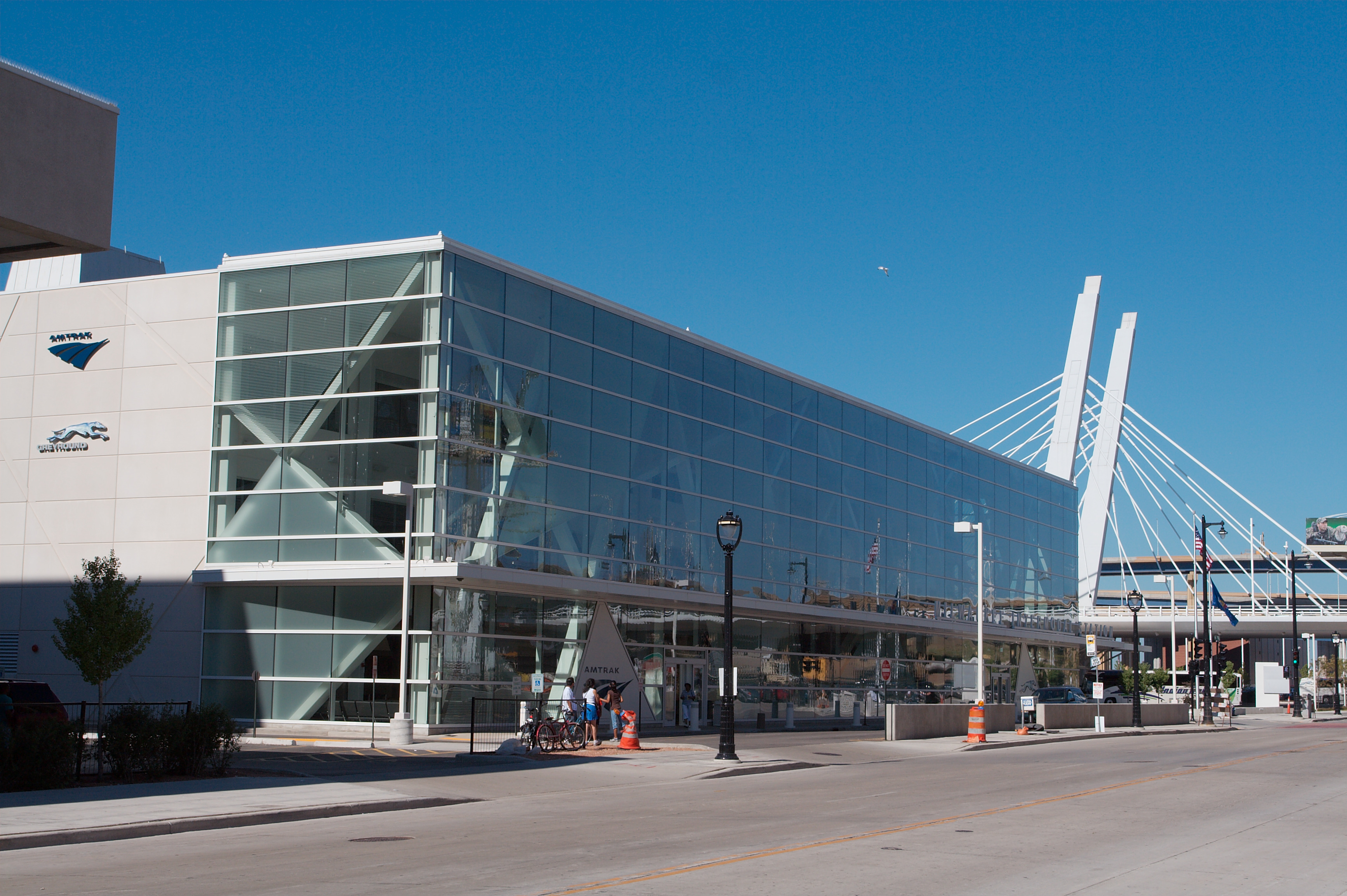

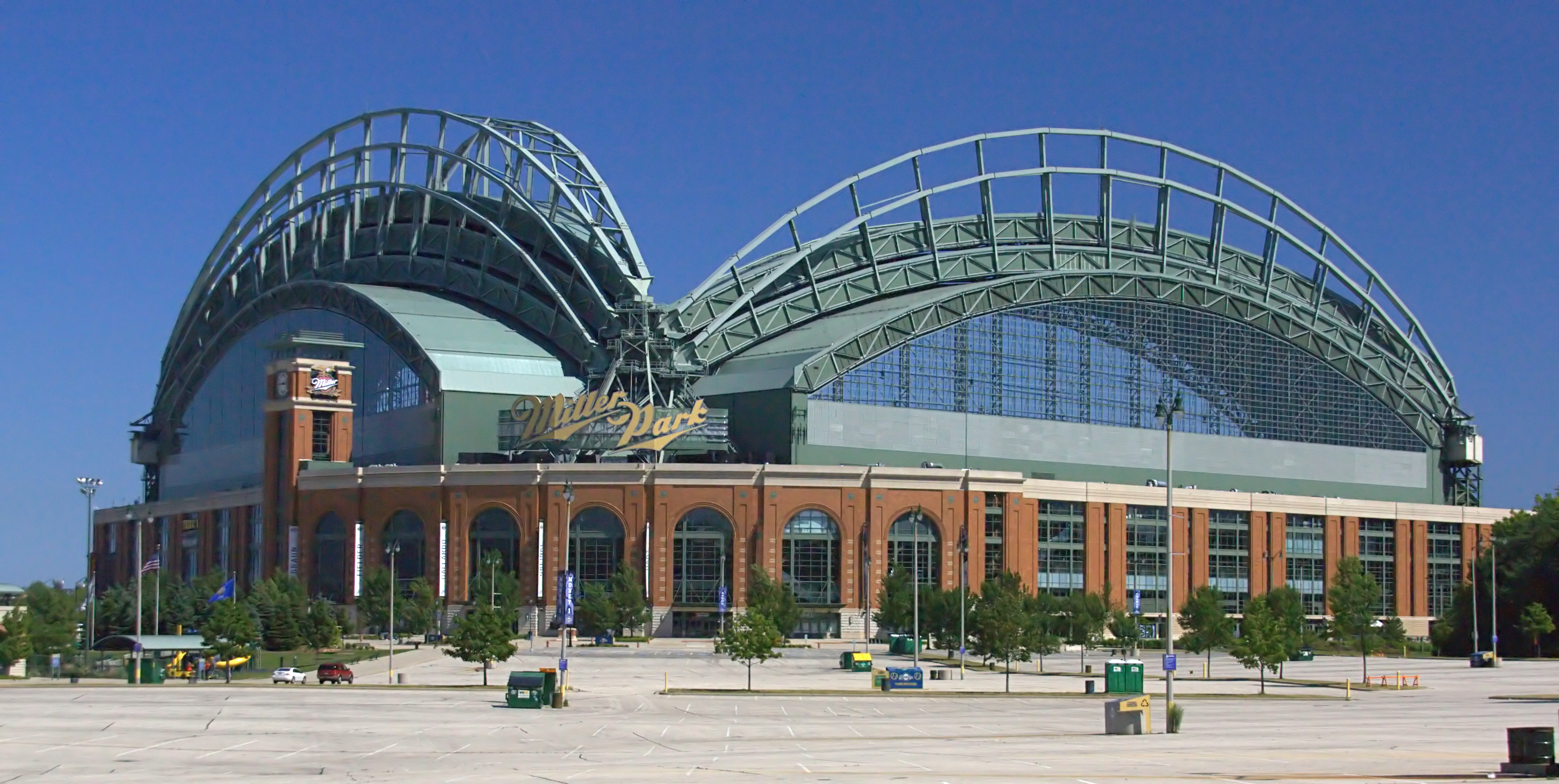
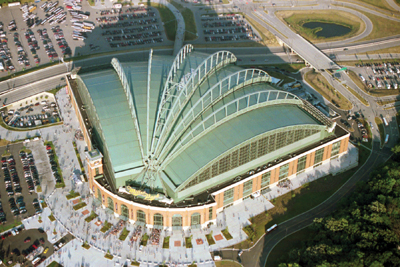


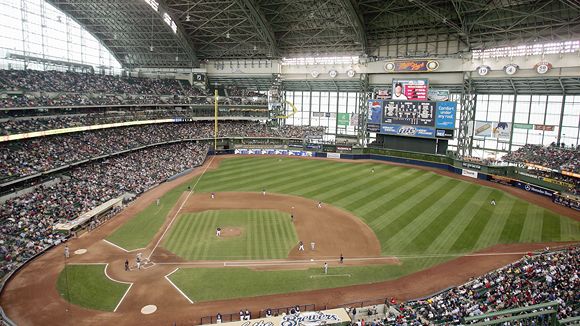







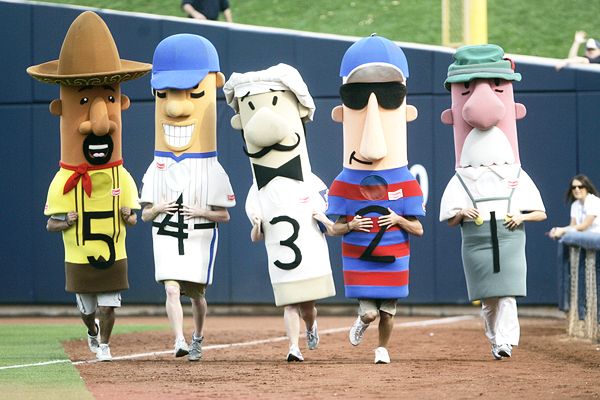
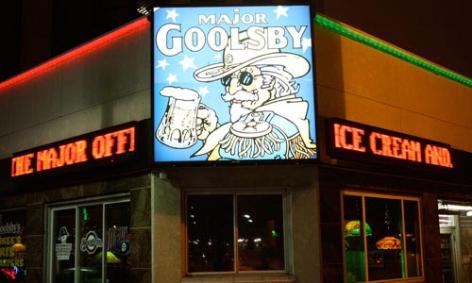

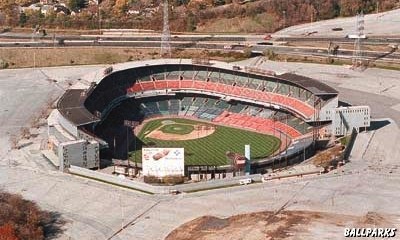



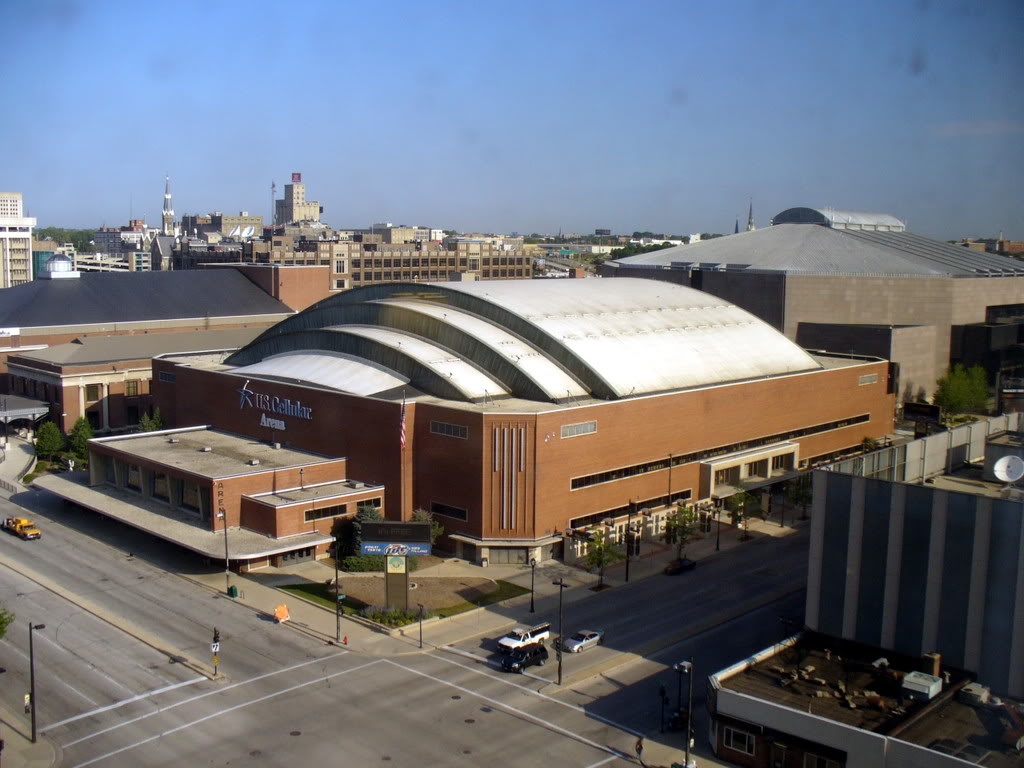



No comments:
Post a Comment